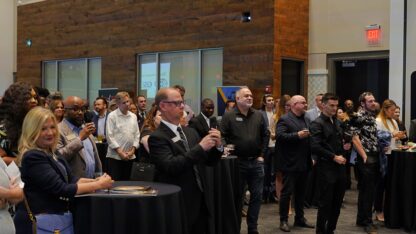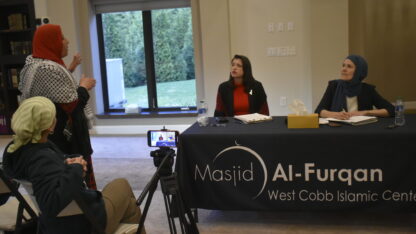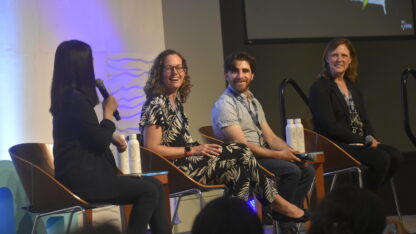Phillip Morris is big guy wearing a Confederate flag bandana.
“We’re trying to show that look, it’s not about hate, it’s all about heritage,” said Morris. “We got food and water for anybody that comes up. They’re welcome to sit and talk to us. We’re not going to run anybody off.”
But did he feel like his heritage needed defending?
“I guess being proud of being white is being attacked at the moment, for standing behind the Confederate flag. Everyone’s trying to take it as a sign of racism. Which it has nothing to do with racism. The flag doesn’t say racist. It’s the person behind the flag,” he said.
But, the people behind the battle flag change over time, said Georgia State University historian Cliff Kuhn. It has its origins, of course, in the Civil War, honored in its immediate aftermath as a historical relic.
“Its popularity has definitely expanded in over the last half-century in large part as part of the resistance to the civil rights movement in the 1950s and 1960s,” said Kuhn.
After that, in the ’70s, it became a cultural touchstone, he said. Bands like Lynyrd Skynyrd and TV shows like the “Dukes of Hazzard” popularized the flag as a symbol of the spirit of rebellion.
Today, many flag supporters say it’s a symbol of history, but tend to overlook the flag’s segregationist past during the civil rights era. At the same time, says Kuhn, they echo it.
“It is couched in this notion of ‘This is my right to wear what I want, to display what I want.’ And it’s interesting that the language of the civil rights movement gets turned around in this way in terms of, ‘You are taking away my rights, I am the victim,’” he said.
That sense of victimhood is a drastic contrast from a larger national conversation about policing in communities of color and about systemic white privilege. But at the same time, said Kuhn, it’s no wonder some white Southerners are feeling defensive.
“One of the side effects of drawing attention to the Confederate flag, there’s a scapegoating of the South and a white washing of the other parts of the country’s complicity in a national racism,” he said. Historically, this sense of being under attack, and criticized by outsiders, has accompanied surges in flag’s popularity.
There was no shortage of tense moments at the Stone Mountain rally. Each of them was intensified by the huge number of handguns and assault rifles present in the giant parking lot.

At one point, a Ku Klux Klan member was run off from the main part of the rally. Another man ran up slamming a torn up Confederate flag on the ground, taunting the ralliers to climb over an iron fence and stop him.
But each time there was a flare-up, some in the crowd would urge calm. This is what they want, people said. Just ignore them ─ the Confederate pride version of “don’t feed the trolls.”
Morris says it makes him angry supporters of the flag are painted with one broad, ugly brush. That image is one Morris and many who WABE talked to at the rally were very anxious about.
“It’s difficult to talk about … I’m tired of being labeled a racist when I’m the most loving person out here. I’ll give anyone the shirt off my back,” said Morris.
A few weeks ago, Morris organized a flag rally in his home town of Monroe, Georgia, which is where in 1946, two African-American couples, including a pregnant woman, were lynched at Moore’s Ford Bridge. He said he unknowingly scheduled the rally for the same day of the anniversary of the lynching.
“I changed my route, out of respect, because we [were] fixed to go right by the Moore’s Ford remembrance event,” he said.
He says he’s been getting death threats since then.
“The lynching in Walton County. They came by our house with the lynching crew. Maybe they don’t know what it symbolizes. We lived it,” says Hattie Witlock, another Monroe resident.
Just up Robert E. Lee Boulevard, a little way from the flag rally, Witlock was picnicking in the park with more than 300 relatives for a family reunion. The gathered family, almost the same size as the rally, traces their roots back to Hamp and Georgiann Bradley, two freed slaves.
“We’re not hateful toward them. We’re not [going] be that way. When you look at that flag, that was an era that they didn’t want to leave. That was about holding people as slaves,” said Hattie’s husband, George Witlock.
At that moment, a steady stream of people holding huge Confederate flags pass by on their way up Stone Mountain. The sight brings back visceral memories for George Witlock.
“We had to get off of the road. The Klan would come by riding, some of them on the running boards. I’m 71 years old. I remember back when they did that. And some of them [were] holding shotguns,” said George Witlock.
As a black Southerner, he said, the flag is part of his heritage too ─ a part that he said needs to stay in the past.

 Hundreds rallied at Stone Mountain in support of the Confederate battle flag.
Hundreds rallied at Stone Mountain in support of the Confederate battle flag. 9(MDAxODM0MDY4MDEyMTY4NDA3MzI3YjkzMw004))








